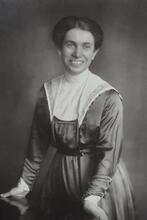Dorothea Hirschfeld
Dorothea Hirschfeld began her career in social work at the Center for Social Work and Care of the Poor in Berlin. At the Center, which she directed from 1924 to 1929, she helped develop the government organization for unemployment aid and worked with the families of World War I victims. Hirschfeld had a social-democratic outlook, believing that abortion and itinerant workers were the result of social causes. Honored by the German Red Cross in 1925, she soon found her employment options restricted by the rule of the National Socialist party. Hirschfeld remained in Germany when the war began. She was deported to Theresienstadt in 1942 but survived and returned to Berlin in 1945.
Too old, lacking an appropriate educational background, of unsuitable family background, a member of the Social-Democrat Party and—worst of all—a woman, Dorothea Hirschfeld, a Jew without any legal training, nevertheless succeeded in entering the civil service at the age of forty-three. In 1919 she was the only woman among twenty candidates recommended for a position at the newly founded Reich Ministry of Employment and, a year later, the only one appointed as ministerial adviser.
Born in Berlin on February 26, 1877, Hirschfeld came from an upper-middle–class background. Her father, Julius Hirschfeld (d. 1897), was a businessman. Her mother, Anna (née Stern), died in 1917. Though her family celebrated the Jewish High Holy Days, they also celebrated Christmas and considered themselves German citizens of the Jewish faith.
After completing schooling at the municipal Viktoria High School, Hirschfeld began professional life as a secretary and librarian before becoming a research assistant at the Center for Social Work and Care of the Poor established in Berlin by Emil Münsterberg (1863–1916). Here she learned the basics of social work; for this she was forever grateful to Münsterberg whose role as director she took over after his death. For fifteen years she worked primarily at the main office of free social welfare and during World War I also in an aid society of women’s national service and a Berlin Care Center for family survivors of war victims. Despite the suspicion of her male colleagues, she made a successful transition from voluntary social work to ministerial social bureaucracy. As its director from 1924 to 1929 she played a significant role in the development of the Reich Institute for Employment Exchanges and Unemployment Insurance.
She established invaluable collaboration with well-known representatives of the women’s movement, such as Dr. Marie Elisabeth Lüders of the Ministry of the Interior and Dr. Marie Oppenheimer. She also nurtured contacts with professional women from her previous area of employment, such as Helene Simon, a well-known sociologist and Social Democrat. She also became active as a lecturer and trustee at the newly founded School of Social Work (AWO) and as a member of its board of governors.
Hirschfeld considered herself above all an expert in social welfare with a social-democratic outlook. Opining that such phenomena as abortion and itinerant workers were the result of social causes, she pleaded for improved care. Her work received recognition beyond the welfare establishment. In 1925 she was honored by the German Red Cross. Nevertheless, in 1930 the National Socialist faction in the Reichstag demanded that her services be made available only to citizens of the Jewish race. On April 24, 1933, she was placed in temporary retirement.
Unlike some of her relatives, a number of whom she helped to emigrate, Dorothea Hirschfeld did not leave Germany, feeling herself too closely connected to the country. On October 3, 1942, at the age of sixty-five, she was deported to Theresienstadt. At the beginning of August 1945, she returned to Berlin, where she was active for about two years as a social consultant. She maintained contact with her former colleagues and with social democrats, remaining interested in social problems until her death on June 12, 1966.
Selected Works
Die Frauen in der Armen- und Wohlfahrtspflege Deutschlands. Berlin: 1909; “Die zukünftige Versorgung der Kriegshinterbliebenen.” In Die Frau 27 (1920): 282–284.
“Die Zusammenarbeit von Sozialversicherung und Wohlfahrtspflege.” Arbeiterwolhfahrt 2 (1928): 225–231.
“Die Wohlfahrtspflege und das Gesetz über die Arbeitsvermittlung und Arbeitslosenversicherung.” Arbeiterwohlfahrt 3 (1928): 353–363.
“Die Reichsfürsorgestatistik.” Arbeiterwohlfahrt 7 (1932): 648–654.
“Vom Armenwesen zur sozialen Fürsorge. Erinnerungen aus meiner Tätigkeit im Reichsarbeitsministerium.” In Neues Beginnen. Zeitschrift der Arbeiterwohlfahrt. Bremen: 1954, 53.
SELECTED WORKS BY DOROTHEA HIRSCHFELD
Jüdische Frauen im 19. Und 20. Jahrhundret: Lexikon zu Leben und Werk. Edited by Jutta Dick and Marina Sassenberg. Rowohlt, Reinbek, 1993.
Lembeck, Elisabeth. “Eine vergessene Pionerin: Die Ministerialrätin Dorothea Hirschfeld.” In “Die Partizipation von Frauen an der öffentlichen Verwaltung in der Weimarer Republik 1918–1933.” Dissertation. Hannover: 1991, 198–210.
Schulz, Ulrike. “Das Reichsarbeitsministerium 1919–1945. Organisation, Führungspersonal und politische Handlungsspielräume.” Alexander Nützenadel (Hg.). Das Reichsarbeitsministerium im Nationalsozialismus. Verwaltung – Politik – Verbrechen. Göttingen, 2017, 33-102.



